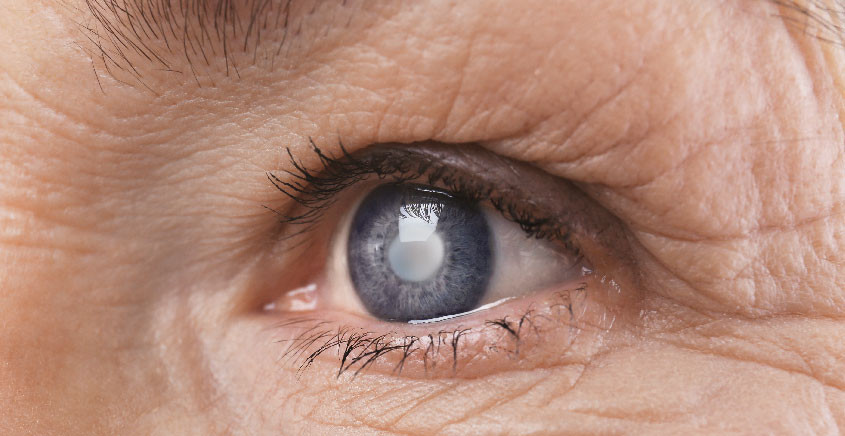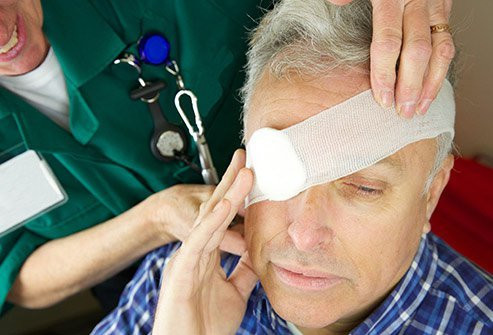Definition
Cataract is a condition where the eye's lens becomes cloudy, leading to decreased vision and eventually blindness. In Indonesia, 81% of blindness is caused by cataracts, affecting about 1.3 million people. Globally, around 94 million people suffer from cataracts.
Causes
Cataracts are generally caused by factors related to aging or lifestyle choices over one's lifetime, occurring naturally. In addition to aging, ultraviolet radiation from sunlight and eye injuries can also cause cataracts, either shortly after the injury or years later.
Risk factor
Things are a risk factor for cataracts other than fairly varied age, such as smoking, drinking often alcoholic beverages, often spending time in the open in the sun, for example farmers, a history of cataracts in the family, a history of diabetes, a history of previous eye surgery, for example surgery. glaukoma, taking anti-inflammatory drugs for a long time for people who have a history of diseases who take anti-inflammatory drugs regularly.
Symptoms
Generally, people do not feel any disturbance when cataracts first appear. Still, as time passes and the eye lens becomes increasingly cloudy, the first thing to complain about is impaired vision. Some examples of symptoms that can occur are:
- Blurred or cloudy vision
- Bright colors look faded
- A ring of light appears around the light source
- Double vision
- Sensitivity to light sources such as lamps, flashlights or car lights
- Difficulty seeing at night or requiring more light sources than usual
The above symptoms may not appear at the same time; symptoms can appear one by one and will persist and then get worse over time.
Diagnosis
When you experience visual disturbances, you should immediately see an eye doctor. Your eye doctor will thoroughly examine your eyes, starting from your vision ability to the structure of your eyeballs if necessary.
For cataracts themselves, the examinations that will be carried out by an eye doctor include visual acuity examination, eye pressure examination, and examination of eye structures such as the cornea, iris and lens of the eye. Your eye doctor will also drop eye drops that help your eyes open wide to facilitate eye examinations. You should be accompanied by family or relatives when doing this examination because for a few moments after the examination is complete your vision may feel blurry and sensitive to light
Management
For the management of cataracts itself, surgery is needed to remove the cloudy lens and replace it with a new lens that is implanted in the eyeball. Cataract surgery should be performed if:
- Decreased visual acuity despite using glasses or other aids
- Other conditions such as lens dislocation and certain glaucomas are found
- The need to examine the back and inside of the eye in eyes that still have the potential to see but the examination is complicated by cataracts
- Decreased visual acuity due to cataracts that interfere with daily activities
Cataract surgery should not be performed if:
- You are not willing to undergo surgery
- Glasses or other aids are sufficient for vision needs
- Surgery can endanger your health due to other conditions or diseases
- Post-operative care cannot be carried out properly
If you are not willing to undergo cataract surgery or cataracts have not yet interfered with your daily activities. Some steps you can take to make your life easier with cataracts are:
- Using brighter light at home or work
- Using glasses or eye aids so that your vision is not glare
- Using a magnifying glass to read
Complications
If left untreated, all cataract sufferers will eventually go blind. Because vision is impaired, cataracts can increase the chances of injury due to accidents or unintentional events. In addition, cataracts can increase the risk of other eye diseases such as glaucoma and, if not treated immediately, will increase the risk of unexpected effects after surgery.
After cataract surgery, regular check-ups with your eye doctor are still necessary to anticipate unwanted events that can occur immediately after surgery or over a longer period, such as blurred vision due to scar tissue after surgery. This condition can be caused by several things such as:
- Scar tissue in the eye after surgery
- Damage to the eyeball tissue
- Eyeball infection
- Inflammation in the eyeball
- Bleeding in the eyeball
- The lens is displaced from its original position
Cataracts in Children
Children can also experience cataracts. This condition can occur because the child is born with cataracts or the child's eye lens becomes cloudy gradually during the growth and development process. This condition is indeed rarer and is generally related to family history. However, it is possible that other causes such as radiation, eye injuries and long-term anti-inflammatory drugs can also cause cataracts in children.
Cataracts in children should be treated immediately before this condition causes other visual disturbances such as lazy eye.
Prevention
Before seeing a doctor, there are steps you can take to help prevent cataracts from forming in your eyes. These steps are:
- Start quitting smoking if you were previously a smoker
- Reduce drinking alcohol more than normal, for men it should be no more than 2 glasses a day and for women no more than 1 glass.
- Avoid long-term outdoor activities under the hot sun. If possible, wear anti-ultraviolet radiation glasses to protect your eyes when doing outdoor activities.
If you have had cataract surgery, you should continue to have regular check-ups with an eye doctor according to your eye doctor's instructions to anticipate unexpected effects from your previous cataract surgery so that you can prevent worsening or new conditions.
When to see a doctor?
Ideally, eye examinations should be carried out at least once every two years, and for people over 65, they should be carried out at least once a year. This eye examination can be carried out whether you have certain complaints or not as part of a general health examination.
You should immediately have a check-up
Looking for more information about other diseases? Click here!
- dr Anita Larasati Priyono
Kementerian Kesehatan Republik Indonesia. Kemkes.go.id. (2021). Retrieved 5 October 2021, from https://www.kemkes.go.id/article/view/20100600004/katarak-penyebab-terbanyak-kebutaan.html.
Apa itu Katarak? - Direktorat P2PTM. Direktorat P2PTM. (2021). Retrieved 5 October 2021, from http://p2ptm.kemkes.go.id/infographic-p2ptm/gangguan-indera/apa-itu-katarak.
Vision impairment and blindness. Who.int. (2021). Retrieved 5 October 2021, from https://www.who.int/news-room/fact-sheets/detail/blindness-and-visual-impairment.
Keputusan Menteri Kesehatan Republik Indonesia Nomor HK.01.07/MENKES/557/2018 tentang Pedoman Nasional Pelayanan Kedokteran Tatalaksana Katarak Pada Dewasa.
Cataracts | National Eye Institute. Nei.nih.gov. (2021). Retrieved 5 October 2021, from https://www.nei.nih.gov/learn-about-eye-health/eye-conditions-and-diseases/cataracts.
What Are Cataracts?. American Academy of Ophthalmology. (2021). Retrieved 5 October 2021, from https://www.aao.org/eye-health/diseases/what-are-cataracts.










